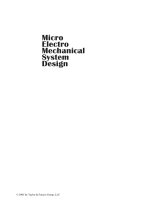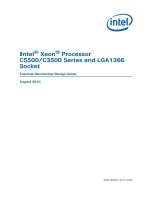Computer-aided design (CAD) potx
Bạn đang xem bản rút gọn của tài liệu. Xem và tải ngay bản đầy đủ của tài liệu tại đây (172.73 KB, 5 trang )
Computer-aided design (CAD), also known as computer-aided drafting and design (CADD),
is the use of computer technology for the process of design and design-documentation. Computer
Aided Drafting describes the process of drafting with a computer. CADD software, or
environments, provide the user with input-tools for the purpose of streamlining design processes;
drafting, documentation, and manufacturing processes. CADD output is often in the form of
electronic files for print or machining operations. The development of CADD-based software is
in direct correlation with the processes it seeks to economize; industry-based software
(construction, manufacturing, etc.) typically uses vector-based (linear) environments whereas
graphic-based software utilizes raster-based (pixelated) environments.
CADD environments often involve more than just shapes. As in the manual drafting of technical
and engineering drawings, the output of CAD must convey information, such as materials,
processes, dimensions, and tolerances, according to application-specific conventions.
CAD may be used to design curves and figures in two-dimensional (2D) space; or curves,
surfaces, and solids in three-dimensional (3D) objects.
[1]
CAD is an important industrial art extensively used in many applications, including automotive,
shipbuilding, and aerospace industries, industrial and architectural design, prosthetics, and many
more. CAD is also widely used to produce computer animation for special effects in movies,
advertising and technical manuals. The modern ubiquity and power of computers means that
even perfume bottles and shampoo dispensers are designed using techniques unheard of by
engineers of the 1960s. Because of its enormous economic importance, CAD has been a major
driving force for research in computational geometry, computer graphics (both hardware and
software), and discrete differential geometry.
[2]
The design of geometric models for object shapes, in particular, is often called computer-aided
geometric design (CAGD).
[3]
Overview
Current computer-aided design software packages range from 2D vector-based drafting systems
to 3D solid and surface modellers. Modern CAD packages can also frequently allow rotations in
three dimensions, allowing viewing of a designed object from any desired angle, even from the
inside looking out. Some CAD software is capable of dynamic mathematic modeling, in which
case it may be marketed as CADD — computer-aided design and drafting.
CAD is used in the design of tools and machinery and in the drafting and design of all types of
buildings, from small residential types (houses) to the largest commercial and industrial
structures (hospitals and factories).
CAD is mainly used for detailed engineering of 3D models and/or 2D drawings of physical
components, but it is also used throughout the engineering process from conceptual design and
layout of products, through strength and dynamic analysis of assemblies to definition of
manufacturing methods of components. It can also be used to design objects.
CAD has become an especially important technology within the scope of computer-aided
technologies, with benefits such as lower product development costs and a greatly shortened
design cycle. CAD enables designers to lay out and develop work on screen, print it out and save
it for future editing, saving time on their drawings.
[edit] Uses
Computer-aided design is one of the many tools used by engineers and designers and is used in
many ways depending on the profession of the user and the type of software in question.
CAD is one part of the whole Digital Product Development (DPD) activity within the Product
Lifecycle Management (PLM) process, and as such is used together with other tools, which are
either integrated modules or stand-alone products, such as:
• Computer-aided engineering (CAE) and Finite element analysis (FEA)
• Computer-aided manufacturing (CAM) including instructions to Computer Numerical
Control (CNC) machines
• Photo realistic rendering
• Document management and revision control using Product Data Management (PDM).
CAD is also used for the accurate creation of photo simulations that are often required in the
preparation of Environmental Impact Reports, in which computer-aided designs of intended
buildings are superimposed into photographs of existing environments to represent what that
locale will be like were the proposed facilities allowed to be built. Potential blockage of view
corridors and shadow studies are also frequently analyzed through the use of CAD.
[edit] Types
The neutrality of this article is disputed. Please see the discussion on the talk page.
Please do not remove this message until the dispute is resolved. (September 2010)
There are several different types of CAD. Each of these different types of CAD systems require
the operator to think differently about how he or she will use them and he or she must design
their virtual components in a different manner for each.
There are many producers of the lower-end 2D systems, including a number of free and open
source programs. These provide an approach to the drawing process without all the fuss over
scale and placement on the drawing sheet that accompanied hand drafting, since these can be
adjusted as required during the creation of the final draft.
3D wireframe is basically an extension of 2D drafting. Each line has to be manually inserted into
the drawing. The final product has no mass properties associated with it and cannot have features
directly added to it, such as holes. The operator approaches these in a similar fashion to the 2D
systems, although many 3D systems allow using the wireframe model to make the final
engineering drawing views.
3D "dumb" solids (programs incorporating this technology include AutoCAD) are created in a
way analogous to manipulations of real world objects. Basic three-dimensional geometric forms
(prisms, cylinders, spheres, and so on) have solid volumes added or subtracted from them, as if
assembling or cutting real-world objects. Two-dimensional projected views can easily be
generated from the models. Basic 3D solids don't usually include tools to easily allow motion of
components, set limits to their motion, or identify interference between components.
3D parametric solid modeling require the operator to use what is referred to as "design intent".
The objects and features created are adjustable. Any future modifications will be simple,
difficult, or nearly impossible, depending on how the original part was created. One must think
of this as being a "perfect world" representation of the component. If a feature was intended to be
located from the center of the part, the operator needs to locate it from the center of the model,
not, perhaps, from a more convenient edge or an arbitrary point, as he could when using "dumb"
solids. Parametric solids require the operator to consider the consequences of his actions
carefully.
Some software packages provide the ability to edit parametric and non-parametric geometry
without the need to understand or undo the design intent history of the geometry by use of direct
modeling functionality. This ability may also include the additional ability to infer the correct
relationships between selected geometry (e.g., tangency, concentricity) which makes the editing
process less time and labor intensive while still freeing the engineer from the burden of
understanding the model’s design intent history. These kind of non history based systems are
called Explicit Modellers or Direct CAD Modelers. The first Explicit Modeling system was
introduced to the world at the end of 80's by Hewlett-Packard under the name SolidDesigner.
Draft views are able to be generated easily from the models. Assemblies usually incorporate
tools to represent the motions of components, set their limits, and identify interference. The tool
kits available for these systems are ever increasing; including 3D piping and injection mold
designing packages.
Mid range software are integrating parametric solids more easily to the end user: integrating
more intuitive functions (SketchUp), using the best of both 3D dumb solids and parametric
characteristics (VectorWorks), making very real-view scenes in relative few steps (Cinema4D) or
offering all-in-one (form•Z).
Top end systems offer the capabilities to incorporate more organic, aesthetics and ergonomic
features into designs (Catia, GenerativeComponents). Freeform surface modelling is often
combined with solids to allow the designer to create products that fit the human form and visual
requirements as well as they interface with the machine.
[edit] Technology
A CAD model of a mouse.
Originally software for Computer-Aided Design systems was developed with computer
languages such as Fortran, but with the advancement of object-oriented programming methods
this has radically changed. Typical modern parametric feature based modeler and freeform
surface systems are built around a number of key C modules with their own APIs. A CAD
system can be seen as built up from the interaction of a graphical user interface (GUI) with
NURBS geometry and/or boundary representation (B-rep) data via a geometric modeling kernel.
A geometry constraint engine may also be employed to manage the associative relationships
between geometry, such as wireframe geometry in a sketch or components in an assembly.
Unexpected capabilities of these associative relationships have led to a new form of prototyping
called digital prototyping. In contrast to physical prototypes, which entail manufacturing time in
the design.
Today, CAD systems exist for all the major platforms (Windows, Linux, UNIX and Mac OS X);
some packages even support multiple platforms.
Right now, no special hardware is required for most CAD software. However, some CAD
systems can do graphically and computationally expensive tasks, so good graphics card, high
speed (and possibly multiple) CPUs and large amounts of RAM are recommended.
The human-machine interface is generally via a computer mouse but can also be via a pen and
digitizing graphics tablet. Manipulation of the view of the model on the screen is also sometimes
done with the use of a spacemouse/SpaceBall. Some systems also support stereoscopic glasses
for viewing the 3D model.
[edit] Effects
The neutrality of this article is disputed. Please see the discussion on the talk page.
Please do not remove this message until the dispute is resolved. (August 2010)
Beginning in the 1980s Computer-Aided Design programs reduced the need of draftsmen
significantly, especially in small to mid-sized companies. Their affordability and ability to run on
personal computers also allowed engineers to do their own drafting work, eliminating the need
for entire departments. In today's world most, if not all, students in universities do not learn
drafting techniques because they are not required to do so. The days of mechanical drawings are
almost obsolete.
[4]
Universities such as New Jersey Institute of Technology no longer require the
use of protractors and compasses to create mechanical drawings, instead there are several classes
that focus on the use of CAD software such as Pro Engineer or IDEAS-MS.
Another consequence had been that since the latest advances were often quite expensive, small
and even mid-size firms often could not compete against large firms who could use their
computational edge for competitive purposes.
[citation needed]
Today, however, hardware and software
costs have come down. Even high-end packages work on less expensive platforms and some
even support multiple platforms. The costs associated with CAD implementation now are more
heavily weighted to the costs of training in the use of these high level tools, the cost of
integrating a CAD/CAM/CAE PLM using enterprise across multi-CAD and multi-platform
environments and the costs of modifying design work flows to exploit the full advantage of CAD
tools. CAD vendors have effectively lowered these training costs. These methods can be split
into three categories:
1. Improved and simplified user interfaces. This includes the availability of “role” specific
tailorable user interfaces through which commands are presented to users in a form
appropriate to their function and expertise.
2. Enhancements to application software. One such example is improved design-in-context,
through the ability to model/edit a design component from within the context of a large,
even multi-CAD, active digital mockup.
3. User oriented modeling options. This includes the ability to free the user from the need to
understand the design intent history of a complex intelligent model.
[edit] See also
Wikiversity has learning materials about Computer-aided design
• CAD standards
• Comparison of CAD editors for AEC (architecture, engineering and construction)
• Comparison of CAD editors for CAE (Computer Aided Engineering)
• Comparison of Free EDA software (Electronic Design Automation)
• 3D computer graphics software
• Comparison of 3D computer graphics software
• Digital architecture
• Electronic design automation
• ISO 128
• List of CAD companies
• Molecular design software
[edit] References
1. ^ Farin, G.: A History of Curves and Surfaces in CAGD, Handbook of Computer Aided
Geometric Design
2. ^ H. Pottmann, S. Brell-Cokcan, and J. Wallner:Discrete surfaces for architectural
design
3. ^ Gerald Farin :Curves and Surfaces for CAGD: A Practical Guide
4. ^ Stephen J. Mraz:Changes in the Engineering Profession Over 80 Years
This article needs additional citations for verification.
Please help improve this article by adding reliable references. Unsourced material may be challenged and
removed. (May 2009)
[edit] External links
Wikimedia Commons has media related to: Computer Aided Design (CAD)
Look up computer-aided design in Wiktionary, the free dictionary.
• CAD Digest, Links to thousands of CAD, CAM & CAE articles collected from all over
the Web!
• Computer Aided Geometric Design
• Oral history interview with Carl Machover , Charles Babbage Institute, University of
Minnesota. Machover is a computer graphics pioneer and president of Machover
Associates, a computer graphics consultancy founded in 1976. Formation of Information
Displays, Inc. (IDI) and creation of stand-alone computer-aided design (CAD) platform
the IDIIOM (IDI Input-Output Machine). Comments on TV scan versus vector scan, the
relative merits of color and 3D information displays, potential health problems related to
flickering display and jitter, and the adoption of CAD/CAM (Computer-Aided
Design/Computer-Aided Manufacturing), and ACM's SIGGRAPH CORE graphics
standard in the 1970s.
• upFront.eZine Reporting on CAD software since 1985.









